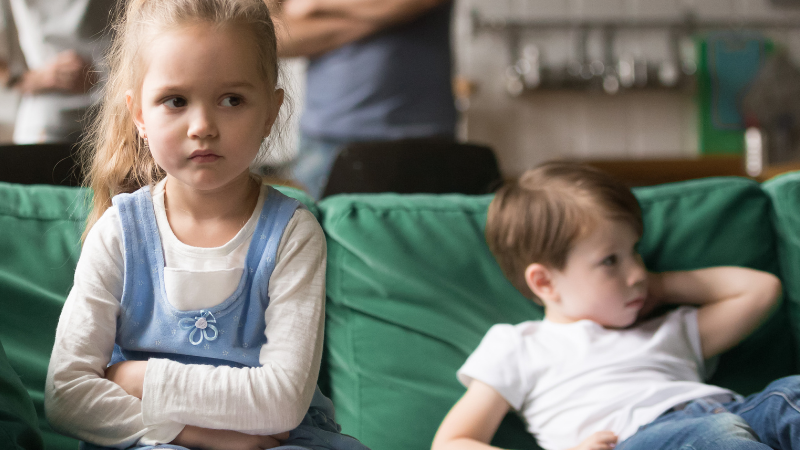Hot Topics
What About The Children?

Divorce is a “death,” a “loss” not only for the parents but for the children as well. Each will experience the grief process in a different way, and the children are the last to begin. The intensity and duration of their grieving will be influenced by the level of conflict during the divorce.
Children grieve how life used to be. They have difficulty accepting that their parents are no longer together, and that their family is no longer a single unit. They may fantasize about reconciliation and be disappointed when it does not happen. Besides dealing with the loss of the family unit, children also have the added stress of living in 2 separate homes, with 2 separate rules, and moving themselves and their belongings back and forth. And being exposed to the arguments and conflicts between the parents, intensifies their stress. Children are damaged when their parents fight in front of them, over them, and through them.
Children can experience difficulties in many areas when their parents are going through a contentious divorce process. They may experience emotional issues, such as depression, anxiety, excessive worrying, guilt, self-blame, lower self-esteem, fear, separation anxiety, and anger. They may feel responsible for their parents divorcing. They may be angry and frustrated that their parents cannot communicate or treat each other with respect. They may also feel nervous or scared about what to expect in the present and future. If there is a high level of conflict between the parents for an extended period, a child’s symptoms may become internalized and develop into a more serious mental condition, such as an anxiety disorder, a depressive disorder, or a somatic symptom disorder.
Children may also experience behavioral issues. These can include antisocial behaviors, conflict with authority, impulsivity, oppositional behavior, and/or impaired social relationships. They may have difficulty adjusting to new relationships or maintaining appropriate boundaries. Children may avoid social contact, verbally attack others, or imitate their parents’ behavior, including displays of anger and frustration. Their academic performance may also be compromised, as evidenced by lower achievement scores and lower grades.
When conflict between parents is escalated, the child may experience a “loyalty bind.” A loyalty bind is when the child tries to maintain a positive relationship with both parents but does not feel supported to do so and feels caught in the middle. The parents speaking negatively about each other or using the child as a messenger between them are examples of what can cause a loyalty bind. The greater the degree of parental conflict, the more intense the loyalty bind becomes for the child. Parental alienation can be a serious consequence of a high-conflict divorce and loyalty bind. This is when the child closely allies with one parent and refuses to have a relationship with the other parent without a good reason.
In a contentious divorce, the parents will most likely be overwhelmed. While the parents are dealing with their own emotional issues and pressures of the divorce process, they are unable to give as much attention to their children. The children face the most difficult changes in their lives without parental support. The more intense the conflict and the longer the duration of the divorce process, the more likely the children will be negatively affected.
A contentious divorce can adversely affect children. And although divorce may be imminent, there are ways in which to mitigate the negative effects on the children. The degree to which the parents can minimize risk factors and maximize protective factors will have a positive influence on the children’s outcomes. A major factor is the reduction of conflict between parents and a focus on cooperative co-parenting with decisive and unified actions. Having a positive co-parenting strategy during the divorce can make a big difference in the children’s emotional well-being. They will be able to provide predictability, stability, and consistency to the children. These three factors are vital in lowering children’s anxiety and stress levels. For example, children need to know who is picking them up from school and that somebody will in fact be there. Children need to have the security of routine and structure as they are adjusting to many new circumstances in the wake of a divorce. They feel safer and more secure when they know what to expect next.
When parents attempt to collaborate amicably and reduce their conflict during their divorce, it will help the children recover and adapt to the new family structure. The parents’ ability and willingness to communicate in a healthy manner will reduce the children’s stress. Parents can help their children grieve their loss and adjust to new circumstances by helping them express their emotions and truly listening to them. Children can heal when they have the support and love of both parents. Parents who have an amicable post-marital relationship can help their children become more confident and have a closer bond to both parents.
Finding a way to divorce respectfully is critical in lessening children’s trauma. In the Collaborative Divorce Process, the well-being of the children and family is a priority. In this process, the Child Specialist gives the parents and professionals an opportunity to know the child’s perspective and needs. A trained mental health facilitator works with the parents to help decrease conflict, increase respectful communication, and learn cooperative co-parenting skills. This process lends itself to a healthier co-parenting relationship which benefits the children. The parents and children can reach the final stage of grief…acceptance. Now, the healing can begin.
